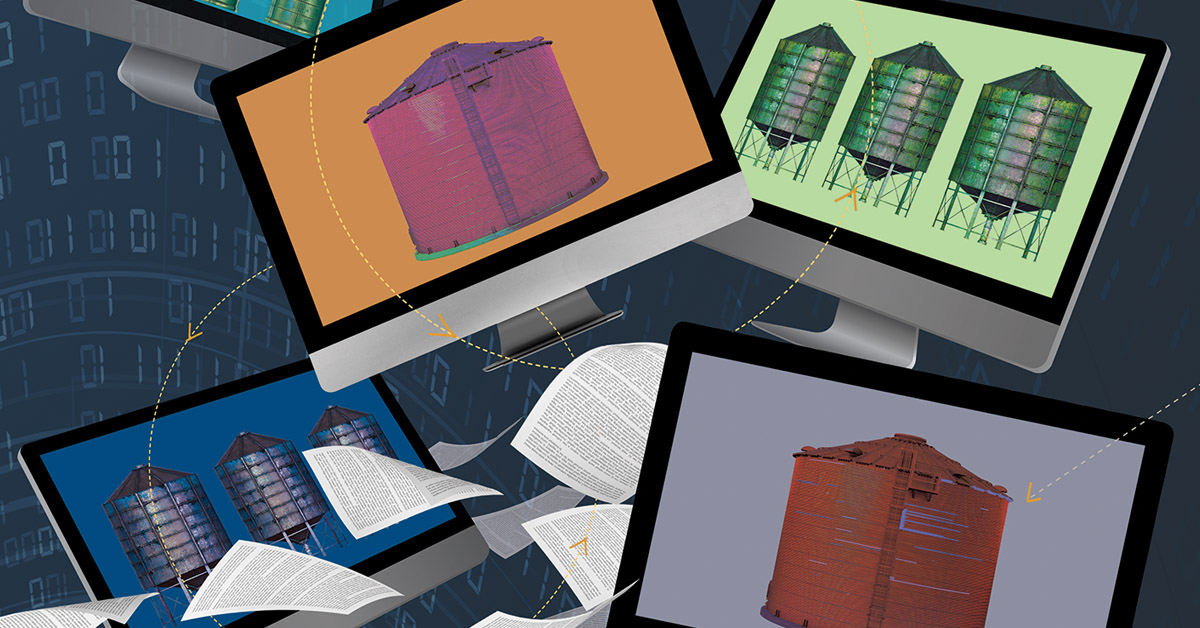At any given moment, it wasn’t uncommon (and still isn’t) to see a mortgage originator or loan officer assistant working from two monitors with five or six windows open while staring at an unauthorized third-party smartphone app, all simply to push the file along. These endless workarounds emerged as new technologies and regulations were added over the past decade.
Too often, mortgage professionals are struggling with these “technology silos,” or apps and software that don’t communicate with each other. This may finally be changing.
For years, new mortgage technologies have been developed with the assumption that they would be the user’s primary technology, with which supporting technologies needed to be integrated in order to coexist. The result, which was especially noticeable
after the implementation of federal mortgage disclosure rules in 2015 and 2016, were these silos — lots of them.
With the murky six-month and one-year outlooks for the market, this will be a true test for lenders and originators alike, each of whom tend to lock down expenses and investments in down markets.
As a result, technology users were often forced to find workarounds or manually transfer data from one technology to another. Needless to say, this tended to diminish or nullify the potential production gains for which new technology was implemented in the first place.
Siloed technology is a very real problem. This is especially true at a time when profit margins will be severely challenged and competition for declining origination volume will be fierce. Technology silos lead to unnecessary rekeying, manual data entry and transfer, and more time in transition from task to task, all of which leads to delays, errors and excessive costs.
Tech silos, in many ways, mirror the age-old inefficiencies that have occurred in the homebuying transaction. For some reason, the mortgage industry simply seems to expect delays from Realtor to originator or originator to title company, even on matters that should be relatively quick and painless such as verifying data or confirming a closing date.
The borrower is told repeatedly that the loan officer or independent mortgage broker is “waiting for a callback” or has “sent an email.” The good news is that the status quo seems to be changing, albeit slowly.
Specific solutions
Take a stroll around the exhibit hall at any mortgage conference. Once, the only option for originators and lenders was a global system designed to do anything and everything. Now, tech stacks are the norm. These are technologies that focus on a few tasks, such as populating closing fees or basic document preparation. They are designed to either coexist with most other technologies available or even integrate with the user’s loan origination or point-of-sale software.
Similarly, customization is not the pricey add-on it once was either. In fact, it’s all but expected by lenders once reluctant to make any investment beyond the bare essentials of technology. Too many originators have told too many horror stories over the years about expensive, shiny new technologies that ended up delivering massive disruptions to the loan processing workflow.
These technologies earned minimal buy-in from frontline mortgage professionals and, in the end, became sunken costs when they didn’t perform as advertised. As a result, today’s mortgage technology buyer demands integrations and customization that all but guarantee the additional cost will deliver a true return on investment.
Another major change in the world of mortgage technology is a decrease in demand for global systems designed to manage seemingly any function in the transaction. In 2022, odds are that a lender looking at new technology is not replacing its capable point-of-sale or loan origination systems, which tend to be investments expected to last a minimum of five years or more.
Instead, lenders and originators shopping on the tech market are seeking very specific solutions for very specific pain points that existing technology does not solve.
As such, there has been a significant increase in the number of tech providers that deliver selective solutions such as electronic disbursement. Unused and overlapping technology functions are simply another place where inefficiencies and unnecessary costs reside, so lenders have learned to focus on purchasing what they need rather than what looks new and exciting at the moment.
Borrower expectations
The mortgage industry, however, still has a way to go when it comes to eliminating silos and building an efficient transactional process.
A McKinsey & Co. study from December 2021 observed that “many mortgage originators still engage in labor-intensive and repetitive fulfillment and servicing, even though there is potential to automate more than half of the tasks across front-to-back processes.” Failure to update legacy processes, the report noted, can increase costs and delays.
In spite of the leaps taken, it still takes about
50 days to get from sales contract to closing. Much of the explanation for this comes from the silos that remain, both in a tech sense and an interparty sense. Mortgage companies have only begun to cross the adoption threshold for selective technologies that improve communication between Realtor and originator, or those that verify a borrower’s information without requiring two voicemails and a text, followed by a bored loan officer assistant dutifully typing the information into a field.
Much of the improvement will come with a continuation of the adoption trend. With the murky six-month and one-year outlooks for the market, this will be a true test for lenders and originators alike, each of whom tend to lock down expenses and investments in down markets. Improved efficiency is a great competitive advantage in these market conditions. Thoughtful lenders and originators will thus continue to selectively improve their tech stacks, demanding customization for their unique needs, product mixes and markets.
The McKinsey & Co. report, which predicted the continued improvement of tech stacks, noted that “some leading players are combining multiple third-party technology components rather than relying solely on a core loan platform.” With that, however, will come the need for technologies that collaborate and coexist.
Larger entities, such as wholesale lenders, also will invest in efficient technology solutions for their partners, such as independent originators. In so doing, one would expect an element of integration as well as customization.
There also needs to be an uptick in technologies that focus on breaking the party-to-party silos (Realtor to closer, appraiser to originator, wholesaler to broker, etc.) as well as making the consumer experience more efficient. Market forces are already beginning to drive lender sentiment in this direction.
Borrower expectations for digital engagement have risen dramatically over the past 18 months, according to the McKinsey study. The company’s research indicates that about 60% of both purchase and refinance borrowers would be open to completing their entire mortgage application online, without phone or in-person support. And borrower satisfaction drops by 15 percentage points if the lender takes more than 10 days to provide a decision on an application.
● ● ●
Mortgage borrowers are frequently asking why they can complete a student loan or auto loan application from an iPhone in 15 minutes. When it comes to getting a home loan, they’re being forced to sit through a 30-minute phone call devoted to upselling in order to get a mortgage approved.
The mortgage business still has plenty of room for improvement. For an industry that still insists on using email inboxes as project management tools and considers a voicemail an act of productivity, the key to progress will come with the continued reduction and eventual elimination of silos. ●
-
Jim Paolino is CEO of LodeStar Software Solutions, which develops loan estimator, sales-management and closing-portal technologies. In this role, Paolino manages the company’s day-to-day operations, and oversees business development and long-term strategic direction. He has a decade of experience developing software solutions specifically for the mortgage and title-insurance spaces. Paolino speaks frequently about technology trends as they relate to compliance, operational efficiency and sales growth.
View all posts







